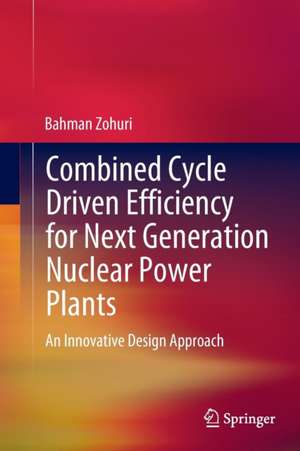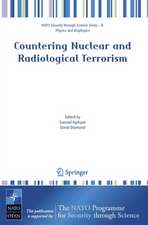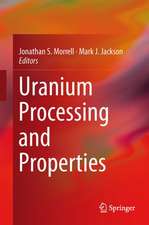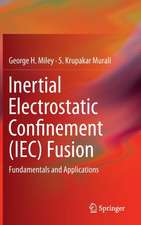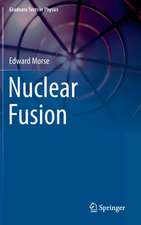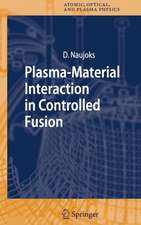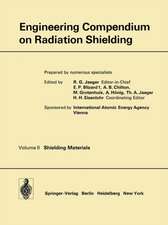Combined Cycle Driven Efficiency for Next Generation Nuclear Power Plants: An Innovative Design Approach
Autor Bahman Zohurien Limba Engleză Paperback – 6 oct 2016
This book explores combined cycle driven efficiency of new nuclear power plants and describes how to model and analyze a nuclear heated multi-turbine power conversion system operating with atmospheric air as the working fluid. The included studies are intended to identify paths for future work on next generation nuclear power plants (GEN-IV), leveraging advances in natural-gas-fired turbines that enable coupling salt-cooled, helium-cooled, and sodium-cooled reactors to a Nuclear Air-Brayton Combined Cycle (NACC). These reactors provide the option of operating base-load nuclear plants with variable electricity output to the grid using natural gas or stored heat to produce peak power. The author describes overall system architecture, components and detailed modelling results of Brayton-Rankine Combined Cycle power conversion systems and Recuperated Brayton Cycle systems, since they offer the highest overall energy conversion efficiencies. With ever-higher temperatures predicted in GEN-IV plants, this book’s investigation of potential avenues for thermodynamic efficiency gains will be of great interest to nuclear engineers and researchers, as well as power plant operators and students.
| Toate formatele și edițiile | Preț | Express |
|---|---|---|
| Paperback (1) | 644.63 lei 6-8 săpt. | |
| Springer International Publishing – 6 oct 2016 | 644.63 lei 6-8 săpt. | |
| Hardback (1) | 651.02 lei 6-8 săpt. | |
| Springer International Publishing – 27 mar 2015 | 651.02 lei 6-8 săpt. |
Preț: 644.63 lei
Preț vechi: 758.38 lei
-15% Nou
Puncte Express: 967
Preț estimativ în valută:
123.35€ • 129.13$ • 102.06£
123.35€ • 129.13$ • 102.06£
Carte tipărită la comandă
Livrare economică 05-19 aprilie
Preluare comenzi: 021 569.72.76
Specificații
ISBN-13: 9783319368580
ISBN-10: 3319368583
Pagini: 382
Ilustrații: XXIII, 359 p. 178 illus., 96 illus. in color.
Dimensiuni: 155 x 235 x 20 mm
Greutate: 0.54 kg
Ediția:Softcover reprint of the original 1st ed. 2015
Editura: Springer International Publishing
Colecția Springer
Locul publicării:Cham, Switzerland
ISBN-10: 3319368583
Pagini: 382
Ilustrații: XXIII, 359 p. 178 illus., 96 illus. in color.
Dimensiuni: 155 x 235 x 20 mm
Greutate: 0.54 kg
Ediția:Softcover reprint of the original 1st ed. 2015
Editura: Springer International Publishing
Colecția Springer
Locul publicării:Cham, Switzerland
Cuprins
Definitions and basic principles.- Properties of pure substances.- Thermodynamic cycles.- Heat transport system thermal hydraulics.- Energy resources and the role of nuclear energy.- New approach to energy conversion technology.- Gas turbine working principles.- Open air brayton gas power cycle.- Modeling the open air nuclear recuperated brayton cycle.- Modelica programming a new approach in modelling of CHP.
Notă biografică
Dr. Bahman Zohuri is founder of Galaxy Advanced Engineering, Inc. a consulting company that he formed upon leaving the semiconductor and defense industries after many years as a Senior Process Engineer for corporations including Westinghouse and Intel and then as Senior Chief Scientist at Lockheed Missile and Aerospace Corporation. During his time with Westinghouse Electric Corporation, he performed thermal hydraulic analysis and natural circulation for Inherent Shutdown Heat Removal System (ISHRS) in the core of a Liquid Metal Fast Breeder Reactor (LMFBR). While at Lockheed, he was responsible for the study of vulnerability, survivability and component radiation and laser hardening for Defense Support Program (DSP), Boost Surveillance and Tracking Satellites (BSTS) and Space Surveillance and Tracking Satellites (SSTS). He also performed analysis of characteristics of laser beam and nuclear radiation interaction with materials, Transient Radiation Effects in Electronics (TREE), Electromagnetic Pulse (EMP), System Generated Electromagnetic Pulse (SGEMP), Single-Event Upset (SEU), Blast and Thermo-mechanical, hardness assurance, maintenance and device technology. His consultancy clients have included Sandia National Laboratories and he holds patents in areas such as the design of diffusion furnaces and Laser Activated Radioactive Decay. He is the author of several books on nuclear engineering heat transfer.
Textul de pe ultima copertă
Introduces the concept of combined cycles for next generation nuclear power plants, explaining how recent advances in gas turbines have made these systems increasingly desirable for efficiency gains and cost-of-ownership reduction
Promulgates modelling and analysis techniques to identify opportunities for increased thermodynamic efficiency and decreased water usage over current Light Water Reactor (LWR) systems
Examines all power conversion aspects, from the fluid exiting the reactor to energy releases into the environment, with special focus on heat exchangers and turbo-machinery
Provides examples of small projects to facilitate nuanced understanding of the theories and implementation of combined-cycle nuclear plants
This book explores combined cycle driven efficiency of next generation nuclear power plants, and describes how to model and analyze a thermally heated multi-turbine power conversion system operating with atmospheric open air as the working fluid. The included studies are intended to identify paths for future work on next generation nuclear power plants (GEN-IV and beyond), leveraging advances in natural-gas-fired turbines that enable coupling salt-cooled, helium-cooled, and sodium-cooled reactors to a Nuclear Air-Brayton Combined Cycle (NACC). These reactors provide the option of operating base-load nuclear plants with variable electricity output to the grid using natural gas or stored heat to produce peak power. The author describes overall system architecture, components, and detailed modeling results of Brayton-Rankine Combined Cycle power conversion systems and Recuperated Brayton Cycle systems, since they offer the highest overall energy conversion and output efficiencies. With ever-higher temperatures predicted in new generations of power plants, this book’s investigation of potential avenues for thermodynamic efficiency gains will be of great interest to nuclear engineersand researchers, as well as power plant operators and students.
Promulgates modelling and analysis techniques to identify opportunities for increased thermodynamic efficiency and decreased water usage over current Light Water Reactor (LWR) systems
Examines all power conversion aspects, from the fluid exiting the reactor to energy releases into the environment, with special focus on heat exchangers and turbo-machinery
Provides examples of small projects to facilitate nuanced understanding of the theories and implementation of combined-cycle nuclear plants
This book explores combined cycle driven efficiency of next generation nuclear power plants, and describes how to model and analyze a thermally heated multi-turbine power conversion system operating with atmospheric open air as the working fluid. The included studies are intended to identify paths for future work on next generation nuclear power plants (GEN-IV and beyond), leveraging advances in natural-gas-fired turbines that enable coupling salt-cooled, helium-cooled, and sodium-cooled reactors to a Nuclear Air-Brayton Combined Cycle (NACC). These reactors provide the option of operating base-load nuclear plants with variable electricity output to the grid using natural gas or stored heat to produce peak power. The author describes overall system architecture, components, and detailed modeling results of Brayton-Rankine Combined Cycle power conversion systems and Recuperated Brayton Cycle systems, since they offer the highest overall energy conversion and output efficiencies. With ever-higher temperatures predicted in new generations of power plants, this book’s investigation of potential avenues for thermodynamic efficiency gains will be of great interest to nuclear engineersand researchers, as well as power plant operators and students.
Caracteristici
Introduces the concept of combined cycle nuclear plants, explaining how recent advances in gas turbines have made these systems increasingly desirable Promulgates modelling and analysis techniques to identify opportunities for increased thermodynamic efficiency and decreased water usage over current Light Water Reactor (LWR) systems Examines all power conversion aspects from the fluid exiting the reactor to the energy releases to the environment, with special focus on heat exchangers and turbo-machinery Provides examples of small projects to facilitate nuanced understanding of the theories and implementation of combined-cycle nuclear plants Includes supplementary material: sn.pub/extras
